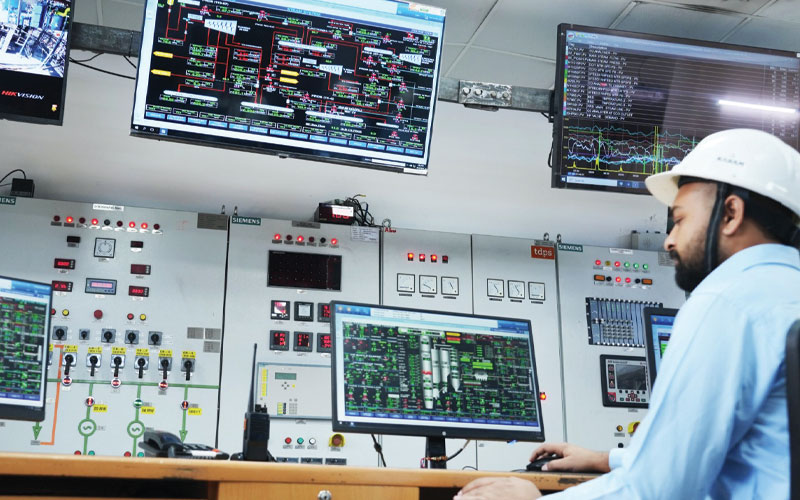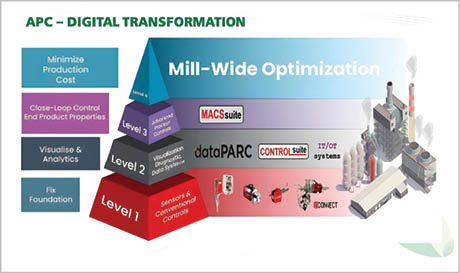Digital twin technology is rapidly redefining operational strategies in India’s paper industry, driving process intelligence, sustainability, and cost efficiency. In this exclusive insight from Kuantum Papers Limited, the company shares its journey of implementing digital twins across pulp, paper, and boiler operations, enabling predictive maintenance, virtual modeling, and real-time optimization. With practical deployment through tools like dataPARC, KPI dashboards and Model Predictive Control systems, Kuantum Papers highlights how this technology is transforming decision-making, resource use, and digital readiness across a traditionally analog sector.

Paper Mart: What role does digital twin technology play in paper industry operations today?
Kuantum Papers: Digital twin technology in the paper industry is emerging as a critical driver of operational predictability, process optimization and intelligent decision-making.
These real-time digital models facilitate performance monitoring, preventing continuous oversight of unit operations in the paper mill. It also supports process optimization by allowing simulations of various operational scenarios and fine-tuning of parameters without risking actual production or actual output.
Predictive maintenance and operations become more proactive with the adoption of digital twin technology, which can forecast wear and potential failure scenarios before they occur. This capability significantly reduces downtime while improving overall efficiency and product quality. In addition, it serves as a valuable training and decision-support tool, allowing operators and engineers to practice scenarios or test changes virtually before applying them on-site.
At Kuantum Papers, digital twin technology is being actively integrated into our core operations through advanced platforms such as dataPARC, KPI dashboards, and Model Predictive Control (MPC) systems. These tools replicate real-time process behaviours across areas including pulp line optimization, paper machine dynamics and boiler steam efficiency.
This system equips us to run optimization models on historical or live data, simulate outcomes before field implementation and improve control loops through AI and closed-loop feedback. We thus view digital twins not as a futuristic idea, but as a living part of our operating system. They help us build process intelligence into every decision, creating a responsive, learning manufacturing environment.
Watch: In Pursuit of Lesser Water Footprint
PM: How do you view the potential or readiness for digital twin applications in Indian paper mills?
KP: The potential for digital twin applications in Indian paper mills is undeniably high, but the readiness varies sharply across the industry due to disparities in automation maturity, data integration and digital literacy. Over the past few years, readiness and acceptability of integration into operations have been gradually improving, especially among large and progressive mills that have embraced automation, real-time data acquisition, and advanced analytics.
Kuantum Papers has laid the groundwork for digital twin implementation through investments in mill-wide Advanced Process Control (APC) systems, integrated digital infrastructure combining DCS, PLCs, lab systems and SAP, and real-time dashboards powered by analytics platforms such as dataPARC. We have also developed soft sensors and virtual models for critical unit operations like agro/hardwood bleaching sequences, agro digester, paper machine wet end operations and power boiler control loops.
Through partnerships with automation providers, we are actively executing one of the first staged digital twin ecosystems in the Indian paper sector. The implementation includes virtual simulations and “what-if” modeling for dynamic process adjustments, predictive maintenance frameworks to minimize downtime and incremental deployment of closed-loop optimization strategies. Such advancements demonstrate not just potential, but practical readiness, backed by both organizational intent and technology infrastructure.

At Kuantum Papers, digital twin technology is being actively integrated into our core operations through advanced platforms such as dataPARC, KPI dashboards, and Model Predictive Control (MPC) systems.
Across the wider Indian paper industry, tier-1 mills (large, integrated players) are moving toward smart manufacturing with partial digital twin implementations. Tier-2 mills (mid-sized producers) are still transitioning, investing in basic automation but lacking integrated platforms. Tier-3 and SME mills face greater constraints, such as limited capital, low automation and minimal exposure to digital transformation.
Despite disparities, rising pressure on sustainability, quality and energy efficiency is pushing the entire industry toward smart manufacturing. Digital twins will play a pivotal role in this shift. In conclusion, while full-scale digital twin deployment is still at a nascent stage across most Indian mills, the industry is beginning to recognize its transformative potential.
India’s paper industry is on the cusp of a digital revolution. While the pace of adoption may vary, the trajectory is irreversible. Digital twins will be at the heart of this transformation, merging physical operations with virtual intelligence to build more agile, efficient and sustainable mills.

PM: What are the key benefits of implementing digital twins in terms of sustainability, cost reduction and process optimization?
KP: Implementing digital twin technology brings multi-faceted value, driving sustainability, cost efficiency and process excellence. At Kuantum Papers, we have experienced firsthand how this technology goes beyond digitalisation. It is a strategic catalyst for smarter, cleaner and more profitable operations.
On the sustainability front, our Model Predictive Control (MPC) systems have helped us optimize chemical usage in pulp bleaching. This has resulted in a 26% reduction in caustic, 24% in oxygen, 10% in hydrogen peroxide, and 10% in chlorine dioxide consumption. Further, this rigorous process control also helped reduce effluent load and air emissions.
In terms of cost reduction, the savings on bleaching chemical consumption translate directly to lower production costs. Through our energy management system, we identified and implemented power-saving measures across pumps and blowers, resulting in energy savings.
Process optimization has been the most transformative aspect. With digital twins, we are able to run virtual experiments, fine-tune operating conditions and maintain tighter control over variables like pulp brightness and chemical usage at the pulp mill.

On the sustainability front, our Model Predictive Control (MPC) systems have helped us optimize chemical usage in pulp bleaching. This has resulted in a 26% reduction in caustic, 24% in oxygen, 10% in hydrogen peroxide, and 10% in chlorine dioxide consumption. Further, this rigorous process control also helped reduce effluent load and air emissions.
PM: What are the challenges in adopting digital twin technology in paper mills?
KP: While the potential of digital twin technology in the paper industry is immense, its successful adoption is not without challenges, especially in the Indian context, where mills vary widely in their level of technological maturity.
The upfront investment required for sensors, software and integration platforms can be significant, especially for mills with limited automation. Integrating digital tools with older machinery is another hurdle, often requiring custom solutions and skilled engineering.
Ensuring data consistency, accuracy and cybersecurity for interconnected systems is critical, but not always easy to manage. A major challenge also lies in developing in-house expertise to interpret advanced analytics and AI outputs.
At Kuantum Papers, we tackled these challenges through a phased strategy. We started with data integration, establishing a single source of truth by bringing real-time and manual data (process, lab and quality) into a common dashboard. Next, we focused on visualization and control by deploying KPI dashboards and trend analysis tools. Once the foundation was set, we initiated the gradual rollout of Model Predictive Control (MPC) loops in prioritized areas, demonstrating ROI before scaling up.
Throughout this process, we emphasized on change management and people upskilling by training teams to work with new tools, understand model behaviour and gain confidence in digital decision-making.
PM: What do you see as the future of digital twin technology in the paper industry, especially in India?
KP: Looking forward, we believe digital twin technology will become an industry standard rather than an exception. As regulatory pressures and customer expectations for high-quality and sustainable products increase, digital twins will be indispensable for mills to attain and maintain competitiveness.
Our future roadmap includes full integration of energy and steam systems for plant-wide optimization, adoption of critical operations across the process areas with a defined scope of improvement, deployment of predictive maintenance models to reduce downtime and development of operator training simulators using real and factual data to improve learning outcomes.
India’s paper industry is on the cusp of a digital revolution. While the pace of adoption may vary, the trajectory is irreversible. Digital twins will be at the heart of this transformation, merging physical operations with virtual intelligence to build more agile, efficient and sustainable mills.

Our future roadmap includes full integration of energy and steam systems for plant-wide optimization, adoption of critical operations across the process areas with a defined scope of improvement, deployment of predictive maintenance models to reduce downtime and development of operator training simulators using real and factual data to improve learning outcomes.



